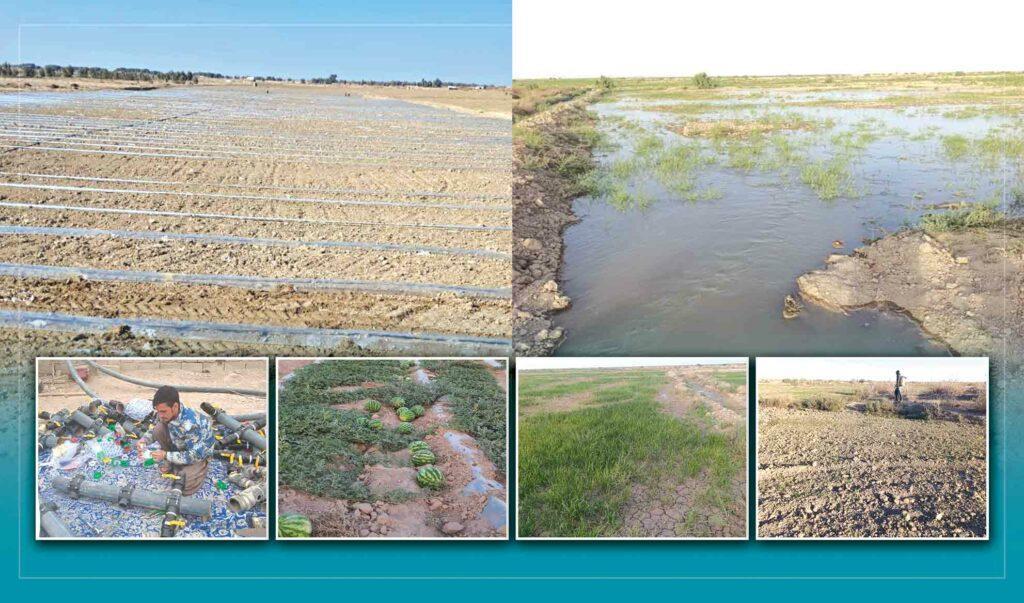
From Drought To Greenery: Some Nimroz Farmers Turn To Drip Irrigation
ZARANJ (Pajhwok): While consecutive droughts in Nimroz province have severely impacted agriculture, recently some farmers have revived their cracked and dried lands by adopting the modern method of drip irrigation, transforming them into green fields once again.
What is drip irrigation?
Drip irrigation is a modern method of watering land where water is delivered slowly and precisely, directly to the roots of plants - drop by drop, not by spraying or flooding.
In this method, instead of distributing water across the entire field (as in traditional methods), pipes, tapes, and drippers are used to deliver water only to the base of each plant or tree.
This significantly reduces water wastage, prevents soil erosion, and improves plant growth.
The essential components for setting up this system include:
-
A water tank or storage source
A water pump to transfer water from the tank to the piping system
Suitable pressure for uniform drip distribution
A filter to prevent particles from clogging the drippers
2-inch or 4-inch polyethylene pipes to deliver water to different parts of the field
Drip tape or subsidiary pipes
Drippers, valves, and automatic controllers or timers
In the scorching heat of Zaranj, where drought has gripped the land like a blade at its throat, a new story is unfolding - one of resilience, innovation, and the return of life to lands once considered beyond hope.
Abdul Ahad , a farmer from the“Nokjo” area of Zaranj city, told Pajhwok Afghan News that consecutive droughts have severely damaged agriculture in the province.
Referring to the time before the droughts, he said he used to grow various vegetables, fruits, and wheat on his lands and earned a decent income. However, the recent years' droughts heavily affected his farming and caused serious economic problems.
He, who supports his family through agriculture, said he had been bewildered in recent years about how to revive his farming.
Abdul Ahad said that by using the drip irrigation system, he was able to rejuvenate his farming and bring his dried lands back to life.
He added:“When I wanted to start drip irrigation farming, I didn't know what to do because I wasn't familiar with it. I went to Iran for a while and worked in an orchard there. I observed their farming methods and learned them. After returning to Nimroz, with great effort, I managed to acquire the necessary equipment from Iran and within the country - it required a large budget.”
He, who now grows melons, watermelons, and various vegetables, said he plans to irrigate wheat using the drip method next year as well.
He added:“The drip system gave very good results. I made a good profit. Compared to traditional irrigation, it's much better - it saves water, costs less, and even if the land is uneven, all parts receive water. If farmers can obtain the equipment, the work is easier and less labor-intensive.”
He said the crop yield from this system is higher:“I've already sent 400 tons of watermelon to other provinces this year. Besides that, we bring 35 to 40 tons to the city daily. The yield is abundant.”
Encouraging other farmers to adopt the drip irrigation system, he called on the Department of Agriculture in Nimroz to provide training programs on this system to farmers.
Haji Mohammad Naeem , another landowner and farmer in the“Qala-i-Fath” area of Zaranj, also uses this system. He said:“For years, drought destroyed our lands and livelihoods. I was desperate and went to Iran due to unemployment. There, I got familiar with the drip irrigation system.”
Having gained good results using the system, he added:“When I used to farm traditionally, due to lack of water, I could only cultivate 50 acres. But now, with drip irrigation, I farm 200 acres. Thankfully, I'm getting abundant yields.”
According to him, equipping each acre with a drip irrigation system costs around 5,000 afghanis, depending on the type of pipe and valves, and could be a little more or less.
He said:“We have a deep well. If we irrigate traditionally, it can water only two acres a day. But with the drip system, it can water ten acres - that's four times more water coverage.”
He now harvests up to 120 tons of watermelon daily from his fields - a figure he couldn't even imagine with traditional methods in past years.
He believes this system is effective not just for melons but for all kinds of crops, orchards, and even home gardens.
Regarding irrigating wheat with the system, he said:
“There are two or three types of drip systems for wheat - one with sprinklers, another with drip tape. Even orchards are irrigated with this system.”
He's been using the system for two years now and noted that initially, only a few farmers adopted it, but now many are using it.
A farmer still using traditional irrigation
Mohammad Sharif , a farmer in Kang district who still uses traditional irrigation, said he cultivated 300 acres this year, but due to drought and delayed water delivery, most of his efforts were wasted.
He said:“Water arrived in the month of Hoot, but it should have been released into the Lashkari canal in Jadi. They didn't do it. As a result, three-quarters of our crops dried up.”
This farmer also plans to switch to the drip irrigation system but cannot afford it due to lack of knowledge and financial issues.
He appealed to the Islamic Emirate and aid organizations, adding:“If the government supports us, agriculture in Nimroz will grow again. This province can become self-sufficient in agricultural products.”
But Mohammad Sharif is not the only one seeking help - many other farmers are calling for assistance as well.
Haji Mir Hamza , another farmer from Nimroz, lamented the drought and said he hasn't harvested anything from his land for the past five years. He has spent all his savings and cannot afford to implement the drip system.
He said:“If the drip system is applied, losses will be minimized. We need support - agriculture in Nimroz must be saved. Drought is a major threat to us.”
Agriculture expert
Farooq Sharifi , an agriculture expert, considers the drip irrigation system a modern and advanced method that significantly reduces water consumption.
He said:“Drip irrigation is an excellent and modern method that reduces water usage and prevents about 60% of water waste on farms.”
Pointing to Nimroz's situation, he said:“Nimroz doesn't have a constant water source, and its underground water is saline and alkaline. This system can prevent water loss.”
He believes promoting drip irrigation can be a major step toward agricultural growth and self-sufficiency in Nimroz and other drought-affected regions.
Agriculture Department
Asadullah Safi , Head of Agricultural Extension at the Department of Agriculture in Nimroz, also believes that applying the drip system for growing melons and various plants can yield excellent results.
However, he said that so far, no government institution or partner organization has taken practical steps in this regard.
He added:“To date, no practical steps have been taken by any organization, as this requires significant funding and long-term planning.”
According to Asadullah, about 150 to 200 hectares of land in areas like Lakri, Sabzgazi, Nokjo, and Qala-e-Fath have been equipped with the drip irrigation system.
He stated that the cost of installing the system on one acre of land is about 30,000 to 40,000 afghanis .
He added:“We've submitted this project to the Ministry of Agriculture several times, but no progress has been made so far.”
He believes that with the ministry's support, this system could be widely implemented across Nimroz.
sa/ma

Legal Disclaimer:
MENAFN provides the
information “as is” without warranty of any kind. We do not accept
any responsibility or liability for the accuracy, content, images,
videos, licenses, completeness, legality, or reliability of the information
contained in this article. If you have any complaints or copyright
issues related to this article, kindly contact the provider above.

















Comments
No comment